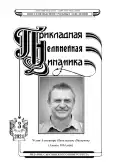A new approach to mathematical modeling of chemical synapses
- Authors: Glyzin D.S.1,2,3, Glyzin S.D.3, Kolesov A.Y.3
-
Affiliations:
- National Research University "
- Higher School of Economics"
- P. G. Demidov Yaroslavl State University
- Issue: Vol 32, No 3 (2024)
- Pages: 376-393
- Section: Nonlinear dynamics and neuroscience
- URL: https://journals.rcsi.science/0869-6632/article/view/256164
- DOI: https://doi.org/10.18500/0869-6632-003099
- EDN: https://elibrary.ru/RJHLMQ
- ID: 256164
Cite item
Full Text
Abstract
About the authors
Dmitriy Sergeyevich Glyzin
National Research University "Higher School of Economics"; P. G. Demidov Yaroslavl State University
ORCID iD: 0000-0002-0701-622X
SPIN-code: 8811-1882
Scopus Author ID: 57214325467
ResearcherId: F-2323-2014
ul. Myasnitskaya 20, Moscow, 101000, Russia
Sergey Dmitrievich Glyzin
P. G. Demidov Yaroslavl State University
ORCID iD: 0000-0002-6403-4061
Scopus Author ID: 8922584500
ResearcherId: B-2224-2013
150000 Yaroslavl, Sovetskaya str., 14
A. Yu. Kolesov
P. G. Demidov Yaroslavl State University
ORCID iD: 0000-0001-5066-0881
150000 Yaroslavl, Sovetskaya str., 14
References
- Hodgkin A. L., Huxley A. F. A quantitative description of membrane current and its application to conduction and excitation in nerve // Journal of Physiology. 1952. Vol. 117. P. 500–544. doi: 10.1113/jphysiol.1952.sp004764.
- Ижикевич Е. М. Динамические системы в нейронауке. Геометрия возбудимости и пачечной активности. М.; Ижевск: Ижевский ин-т компьютерных исследований, 2018. 520 с.
- Колесов А.Ю., Колесов Ю. С. Релаксационные колебания в математических моделях экологии. Тр. МИАН, 199. М.: Наука, 1993. 126 с.
- Майоров В. В., Мышкин И.Ю. Математическое моделирование нейронной сети на основе уравнений с запаздыванием // Матем. моделирование. 1990. Vol. 2, no. 11. С. 64–76.
- Hutchinson G. E. Circular causal systems in ecology // Ann. N. Y. Acad. of Sci. 1948. Vol. 50, no. 4. С. 221–246. doi: 10.1111/j.1749-6632.1948.tb39854.x.
- Глызин С. Д., Колесов А.Ю., Розов Н. Х. Релаксационные автоколебания в сетях импульсных нейронов // УМН. 2015. Т. 70, №3(423). С. 3–76.
- Колесов А.Ю., Мищенко Е. Ф., Розов Н. Х. Об одной модификации уравнения Хатчинсона // Ж. вычисл. матем. и матем. физ. 2010. Vol. 50, no. 12. С. 2099–2112.
- Глызин С. Д., Колесов А.Ю., Розов Н. Х. Об одном способе математического моделирования химических синапсов // Дифференц. уравнения. 2013. Vol. 49, no. 10. С. 1227–1244. doi: 10.1134/S0374064113100014.
- Somers D., Kopell N. Rapid synchronization through fast threshold modulation // Biol. Cybern. 1993. Vol. 68. P. 393–407. doi: 10.1007/BF00198772.
- Kopell N., Somers D. Anti-phase solutions in relaxation oscillators coupled through excitatory interactions // J. Math. Biol. 1995. Vol. 33. P. 261–280. doi: 10.1007/BF00169564.
- Мищенко Е. Ф., Розов Н. Х. Дифференциальные уравнения с малым параметром и релаксационные колебания. М.: Наука, 1975. 248 с.
- FitzHugh R. A. Impulses and physiological states in theoretical models of nerve membrane // Biophysical J. 1961. Vol. 1. P. 445–466. doi: 10.1016/S0006-3495(61)86902-6.
- Terman D., Borisyuk A, Friedman A, Ermentrout B. An Introduction to Dynamical Systems and Neuronal Dynamics // Tutorials in Mathematical Biosciences I. Lecture Notes in Mathematics. Berlin, Heidelberg: Springer-Verlag, 2005. P. 21–68. doi: 10.1007/978-3-540-31544-5_2.
- Глызин С. Д., Колесов А.Ю. Об одном способе математического моделирования электрических синапсов // Дифференц. уравнения. 2022. Vol. 58, no. 7. С. 867–881. doi: 10.31857/S037 4064122070019.
- Колесов А.Ю., Мищенко Е. Ф., Розов Н. Х. Реле с запаздыванием и его С1-аппроксимация // В сб.: Динамические системы и смежные вопросы: К 60-летию со дня рождения академика Дмитрия Викторовича Аносова. Тр. МИАН. 1997. Vol. 216. С. 126–153.
- Глызин С. Д., Колесов А.Ю. Бегущие волны в полносвязных сетях нелинейных осцилляторов // Ж. вычисл. матем. и матем. физ. 2022. Vol. 62, no. 1. С. 71–89. doi: 10.31857/S00444669 22010070.
- Глызин С. Д., Колесов А.Ю., Розов Н. Х. Явление буферности в кольцевых генных сетях // ТМФ. 2016. Vol. 187, no. 3. С. 560–579. doi: 10.4213/tmf9052.
- Brown P. N., Byrne G. D., and Hindmarsh A. C. VODE: A Variable Coefficient ODE Solver // SIAM J. Sci. Stat. Comput. 1989. Vol. 10, no. 5. P. 1038–1051. doi: 10.1137/0910062.
- Глызин С. Д., Колесов А.Ю. Периодические режимы двухкластерной синхронизации в полносвязных сетях нелинейных осцилляторов // ТМФ. 2022. Т. 212, № 2. С. 213–233. doi: 10.4213/tmf10191.
Supplementary files










